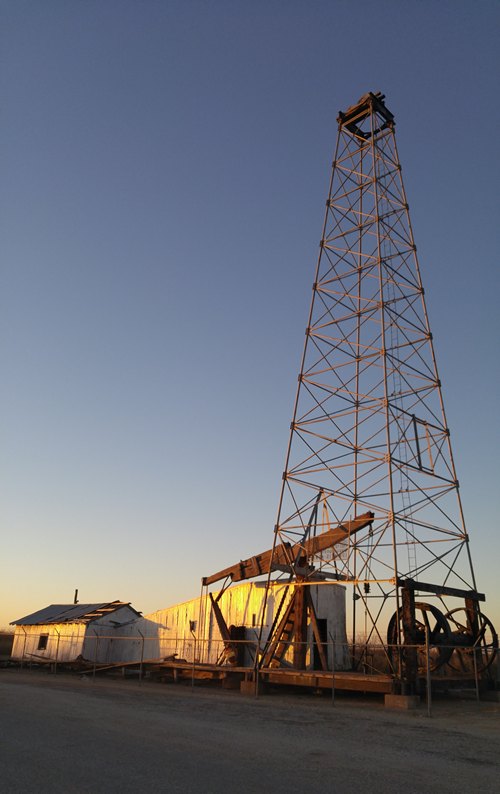|
One
of the things we love about the Texas oil boom of the early 20th century
was how unlikely—even impossible—it all seemed at the time,
but how inevitable it actually was. After all, the oil had been there
for millions of years but nobody paid much attention to it until the
discovery of the Spindletop
oil field in 1901 ignited the Texas oil boom. Until then, Spindletop
was considered a long shot, something on the order of winning the
lottery.
So was Santa Rita No. 1, which came two decades after Spindletop and
was much smaller, but the little rig that could opened up the West
Texas oilfields just as Spindletop had done in Southeast Texas.
Oil scouts and geologists had never thought much of West Texas as
a potential oilfield, but when some of the original fields began drying
up a few wildcatters and gamblers cast their eyes westward, just in
case. |
 |
The well-preserved
remains of Santa Rita #1 in Texon
(about 3 /10 mile south of Hwy 67 on FM 1657).
Photo courtesy Dustin
Martin, January 2018 |
Rupert Ricker
was one of those people. He began buying up leases around his hometown
of Big Lake,
out in the high scrub country of Reagan
County, in 1919. As a lawyer, he was familiar with a 1917 law
that allowed the leasing of state lands for oil exploration, so he
and some friends applied for leases on 431,360 acres in Reagan,
Upton, Irion
and Crockett counties
on land belonging to the University of Texas.
Ricker owed the state $43,136 for the leases and he had 30 days to
pay. He tried to promote the land in Fort
Worth but failed to arouse much interest, so he sold the leases
for $2,500 to an old army friend, Frank T. Pickrell of El
Paso, and his partner Haymon Krupp. Pickrell borrowed money
to cover the filing fee and went to New York to woo investors.
Among the investors was a group of Catholic women. Some silver-tongued
stock salesmen had already persuaded them to invest in the certificates,
and they did, but the women soon suffered a case of buyer's remorse.
They consulted a priest, who suggested they invoke the help of Santa
Rita, the church's Patroness of Impossible Causes.
"These women were a little worried about the wisdom of their investment
and consulted with a priest," Pickrell recalled in a 1969 interview.
"As I was leaving New York on one of my trips to the field, two of
these women handed me a sealed envelope and told me that the envelope
contained a red rose that had been blessed by the priest in the name
of the saint. The women asked me to take the rose back to Texas with
me—to climb to the top of the derrick and scatter the rose petals,
which by then were dry, over the rig and to say, 'I hereby christen
thee Santa Rita.' I faithfully followed those instructions."
A few hours prior to a deadline to begin drilling, driller Carl
Cromwell cranked up Santa Rita No. 1. Pickrell flagged down two
cowboys on the highway and had them sign a statement saying they saw
the rig in operation one day prior to the deadline. A two-man crew
of driller Cromwell and tool dresser Dee Locklin lived at the
site, near the tracks of the Orient Railroad, and went to work.
It didn't go well. Problems were many, workers were few, paychecks
were late, and tools were scarce. The Santa Rita No. 1 rig was down
about the same amount of time it was up and running, and even then
managed little more than four feet a day.
Then things started going a whole lot better.
On May 27, 1923, after drilling into dolomitic sands some 3,000 feet
down, gas bubbles began escaping from the casing head. Cromwell and
Locklin shut the well down and began buying mineral rights in the
area while prices were still low. Even without any more drilling,
the well came in the next day, spewing oil for 250 yards in every
direction. Cromwell and Locklin never developed any of the leases
but later sold them at a considerable profit.
Pickrell and Krupp now had a viable well but they didn't have enough
capital to develop the acreage under their control. Independent oilman
Mike Benedum, a flamboyant wildcatter from Pennsylvania, came
to the rescue. He formed the Big Lake Oil Company and began developing
the field. The major oil companies soon joined the fray. The well
turned out to be a tiny portion of the oil buried in the Permian Basin,
and it made the University of Texas and Texas A&M University, which
received a third of the university's land royalties, the best funded
public educational institutions in the country. They're still pumping
oil out of the Permian Basin.
The Marathon Oil Company replaced the original Santa Rita No. 1 in
1940 with an all-steel pulling derrick and more modern equipment.
The original equipment was preserved through the efforts of the Texas
State Historical Association, and in the 1950s the original Santa
Rita No. 1 was installed on the UT campus in recognition of its importance
to education in the state.
Back in Reagan County,
the revamped Santa Rita No. 1 continued pumping until 1990 when, after
67 years of service, it was taken out of service and plugged. |
|
|
